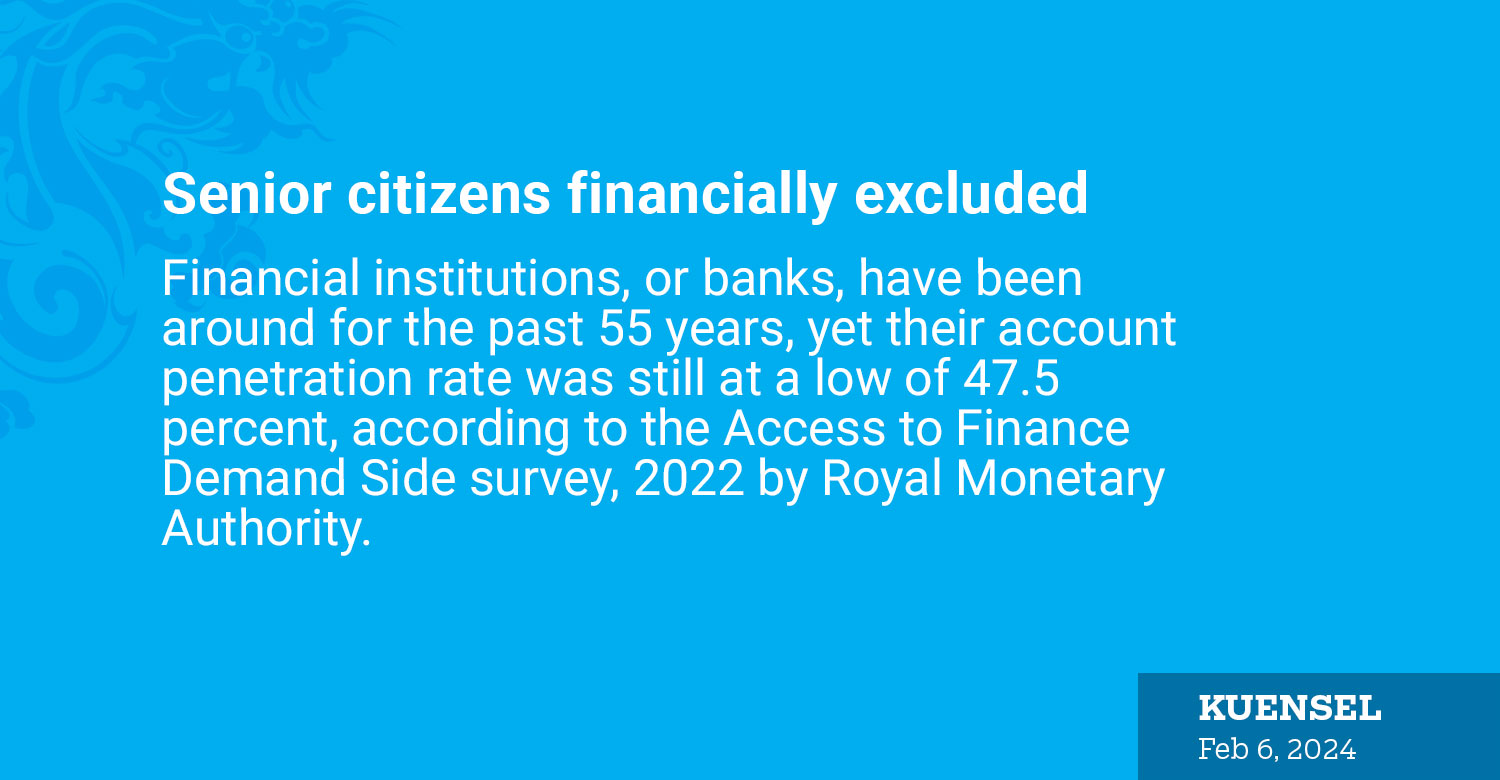Yangyel Lhaden
Financial institutions, or banks, have been around for the past 55 years, yet their account penetration rate was still at a low of 47.5 percent, according to the Access to Finance Demand Side survey, 2022 by Royal Monetary Authority.
In other words, till date only 170,000 banked individuals had access to financial services and products such as automatic teller machine, credit card, electronic money, debit card, and mobile banking, among others.
There were about 350,000 Bhutanese who had an account in a bank.
As a result, the financial exclusion posed significant challenges such as limiting the ability to save, invest, borrow, and manage their finances effectively, the report stated.
The survey further revealed that the financial exclusion rate stood at 19.2 percent for banked individuals. But among the senior citizens aged above 86 years and above the highest financial exclusion rate was at 82.8 percent, while for the youth, it stood at 27.4 percent.
For example, Sonam Tshering, 78, used to invest and buy shares and used a bank account for those purposes when younger. Now he does not even go to the ATM to withdraw money, although he has a bank account, and prefers using cash.
An 81-year-old Yeshi Choden does not have a bank account. For the past 40 years, she had been managing her money she earned from the livestock she sold by letting others borrow, and she made her living through the interest she earned.
In her village Tongling, she lends from Nu 1,000 onwards to her neighbours and other village members at an interest rate of five percent. “Some people borrow Nu 20,000 and some as low as Nu 1,000,” she said. “In the village it is enough money but I do face shortage of money when people do not pay me back on time.”
Yeshi Choden was not interested in opening a bank account. “About 10 years ago, my niece assisted me in making a bank account, but I am uneducated and don’t understand bank procedures, and I don’t need a bank account.”
According to RMA’s survey, 13.3 percent of unbanked individuals said they did not require a bank account. Most respondents said they did not open a bank account because they had no regular income. 93 percent of banked individuals expressed they opened a bank account for savings.
The country’s 80.8 percent of the adult population had a bank account, and only 19.2 percent of the adult population were not banked, according to the survey by the Royal Monetary Authority.
The survey targeted 7,200 households in 20 districts and estimated the adult population to be 448,865 with 57.1 percent or about 250,000 females and 42.9 percent or about 190,000 males.
The survey was conducted with the aim to understand the financial needs and demands of its people by assessing their livelihoods, income sources, and access to formal financial services.
Out of about 350,000 banked individuals, 80.5 percent (about 150,000) were male and 81.1 percent ( about 200,000) were female with 75.1 percent (about 190,000) rural and 91.5 percent ( about 170,000) urban banked individuals.
Having a bank account was important for several reasons, particularly in the context of financial inclusion, bank account ownership was a fundamental measure of financial inclusion and a bank account provided a platform for various financial activities, including saving money, sending or receiving remittances, receiving income and benefits, and facilitating day-to-day payments, the report states.
Choki Wangmo, 48, said that she was in her 20s when her father took her and her siblings to open a bank account at a bank called Bhutan Development Finance Corporation.
“I had no idea what I would use the bank account for, but today I use it to save money in flexi and recurring deposits from the money my children send me. A bank account plays a crucial role in saving money and accessing funds, as it is easier for people to transfer, receive, and save money,” she said.
The report also states about two-thirds of Bhutanese households experienced financial shortages, with rural households more affected than urban. When facing deficits, 83.6 percent borrowed money from family and friends, 32 percent bought essentials on credit, and 4 percent sought help from money lenders or formal financial institutions. Rural households relied more on credit and financial assistance compared to urban households.


